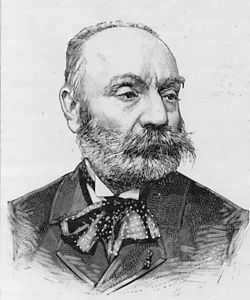Gustave Boulanger


Gustave Clarence Rodolphe Boulanger (1824–88) was a French figure painter known for his classical and Orientalist subjects.
Life
Boulanger was born at Paris in 1824. He studied with Delaroche and Jollivet, and in 1849 took the Prix de Rome.[1] His paintings are prime examples of academic art of the time, particularly history painting. Boulanger had visited Italy, Greece, and North Africa, and his paintings reflect his attention to culturally correct details and skill in rendering the female form.[2] His works include a Moorish Cafe (1848), Cæsar at the Rubicon (1865), the Promenade in the Street of Tombs, Pompeii (1869), and The Slave Market (1888). The recipient of many medals, he became a member of the Institut de France in 1882.[1]
Pupils
Boulanger's students included:
References
- ↑ 1.0 1.1 "Boulanger, Gustave". New International Encyclopaedia 3. Dodd, Mead and Company. 1906. pp. 861–62. Retrieved 7 July 2011.
- ↑ Masler, Marilyn (2009). "Embracing the Academic Tradition". In Masler, Marilyn; Pacini, Marina. Carl Gutherz: Poetic Vision and Academic Ideals. Jackson, Tennessee: University Press of Mississippi. pp. 38–39. ISBN 978-0-915525-11-9.
- ↑ Ernst Friedrich von Liphart, RusArtnet, retrieved 1 January 2014
Sources
![]() This article incorporates text from a publication now in the public domain: Gilman, D. C.; Thurston, H. T.; Moore, F., eds. (1905). "article name needed". New International Encyclopedia (1st ed.). New York: Dodd, Mead.
This article incorporates text from a publication now in the public domain: Gilman, D. C.; Thurston, H. T.; Moore, F., eds. (1905). "article name needed". New International Encyclopedia (1st ed.). New York: Dodd, Mead.
| Wikimedia Commons has media related to Gustave Boulanger. |
|